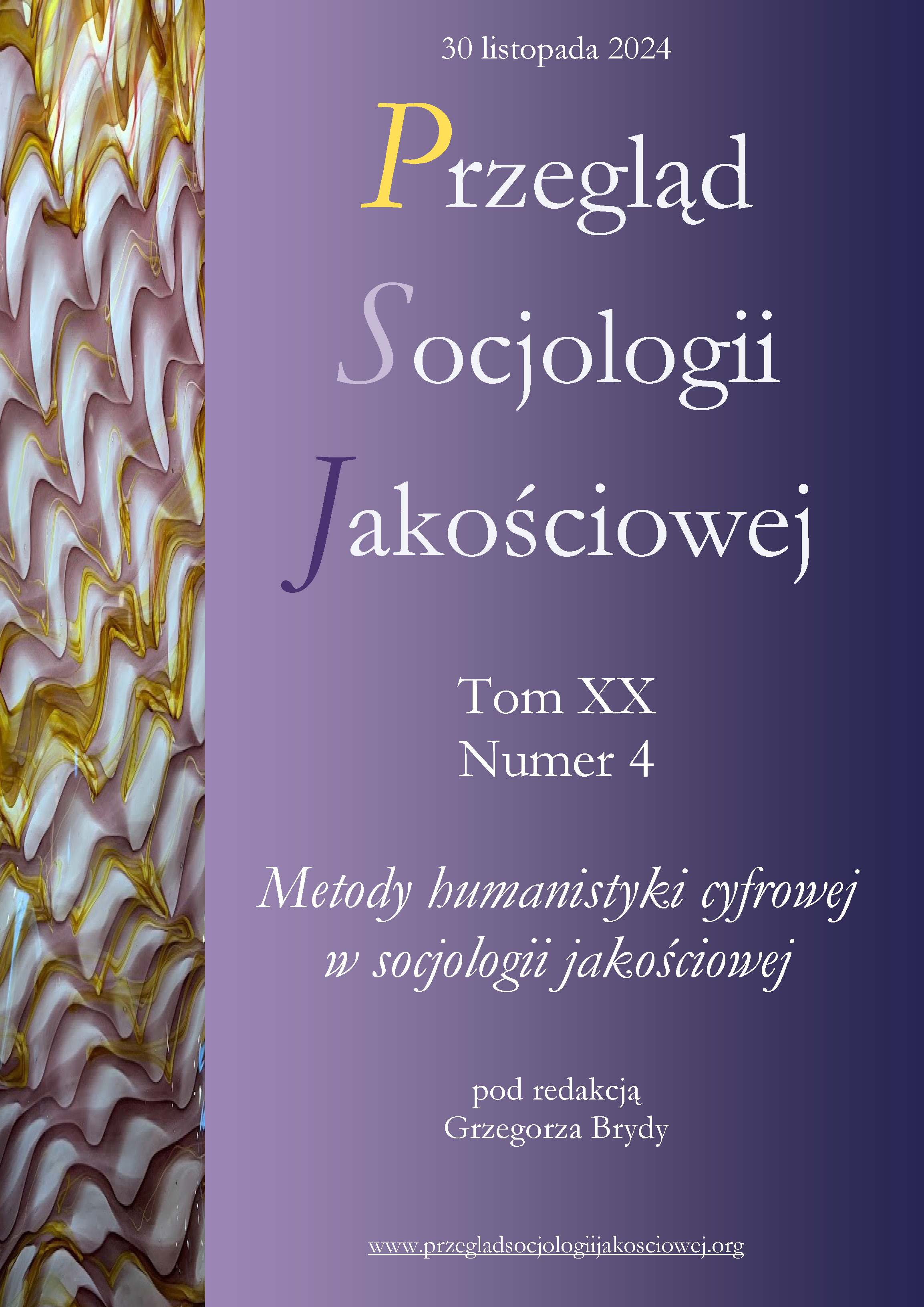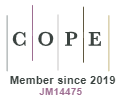Corpus-Assisted Discourse Studies (CADS) as Support for Qualitative Content Analysis: A Case Study Using SketchEngine in Discourse Research
DOI:
https://doi.org/10.18778/1733-8069.20.4.03Keywords:
corpus linguistics, SketchEngine, Qualitative Content Analysis, mixed methodsAbstract
The article presents the potential use of corpus linguistics tools as an initial stage in qualitative content analysis. It discusses the development of Corpus-Assisted Discourse Studies (CADS). The core part of the article is a discussion of the functions of a program supporting CADS – SketchEngine. The text includes numerous examples that illustrate the ways of using CADS methods and SketchEngine functionalities for analyzing Polish press discourse. By enabling easy reference to source texts (concordances), SketchEngine facilitates the inclusion of mixed methods in discourse research.
Downloads
References
Baker Paul (2004), Querying Keywords: Questions of Difference, Frequency, and Sense in Keywords Analysis, „Journal of English Linguistics”, vol. 32(4), s. 346–359, https://doi.org/10.1177/0075424204269894
Google Scholar
DOI: https://doi.org/10.1177/0075424204269894
Baker Paul (2006), Using corpora in discourse analysis, London–New York: Continuum.
Google Scholar
DOI: https://doi.org/10.5040/9781350933996
Baker Paul, Mcenery Tony (2005), A corpus-based approach to discourses of refugees and asylum seekers in UN and newspaper texts, „Journal of Language and Politics”, vol. 4(2), s. 197–226.
Google Scholar
DOI: https://doi.org/10.1075/jlp.4.2.04bak
Baker Paul, Gabrielatos Costas, Khosravinik Majid, Mcenery Tony, Wodak Ruth (2008), A useful methodological synergy? Combining critical discourse analysis and corpus linguistics to examine discourses of refugees and asylum seekers in the UK press, „Discourse & Society”, vol. 19(3), s. 273–306, https://doi.org/10.1177/0957926508088962
Google Scholar
DOI: https://doi.org/10.1177/0957926508088962
Bednarek Monika (2006), Evaluation in Media Discourse: Analysis of a Newspaper Corpus, London–New York: Continuum.
Google Scholar
Chen Yingying, Peng Zhao, Kim Sei Hill, Choi Chang Won (2023), What We Can Do and Cannot Do with Topic Modeling: A Systematic Review, „Communication Methods and Measures”, vol. 17(2), s. 111–130, https://doi.org/10.1080/19312458.2023.2167965
Google Scholar
DOI: https://doi.org/10.1080/19312458.2023.2167965
CLARIN-PL (b.r.), https://ws.clarin-pl.eu/ [dostęp: 10.05.2024].
Google Scholar
CLARIN-PL (b.r.), Login, https://services.clarin-pl.eu/services [dostęp: 10.05.2024].
Google Scholar
Costa Antonio Pedro, Moreira Antonio, Freitas Fabio, Costa King, Bryda Grzegorz (red.) (2023), Computer Supported Qualitative Research, Cham: Springer International Publishing, https://doi.org/10.1007/978-3-031-31346-2
Google Scholar
DOI: https://doi.org/10.1007/978-3-031-31346-2
Creswell John W. (2009), Editorial: Mapping the Field of Mixed Methods Research, „Journal of Mixed Methods Research”, vol. 3(2), s. 95–108, https://doi.org/10.1177/1558689808330883
Google Scholar
DOI: https://doi.org/10.1177/1558689808330883
Efe İbrahim (2019), A corpus-driven analysis of representations of Syrian asylum seekers in the Turkish press 2011–2016, „Discourse and Communication”, vol. 13(1), s. 48–67, https://doi.org/10.1177/1750481318801624
Google Scholar
DOI: https://doi.org/10.1177/1750481318801624
Egbert Jesse, Biber Douglas (2018), Incorporating text dispersion into keyword analyses, „Corpora”, vol. 14(1), s. 77–104, https://doi.org/10.3366/cor.2019.0162
Google Scholar
DOI: https://doi.org/10.3366/cor.2019.0162
Egbert Jesse, Larsson Tove, Biber Douglas (2020), Doing Linguistics with a Corpus. Methodological Considerations for the Everyday User, Cambridge: Cambridge University Press, https://doi.org/10.1017/9781108888790
Google Scholar
DOI: https://doi.org/10.1017/9781108888790
Fairclough Norman (2000), New Labour, New Language?, London: Routledge.
Google Scholar
Gabrielatos Costas (2018), Keyness analysis: Nature, metrics and techniques, [w:] Charlotte Taylor, Anna Marchi (red.), Corpus Approaches To Discourse: A critical review, Oxford: Routledge, s. 225–258.
Google Scholar
DOI: https://doi.org/10.4324/9781315179346-11
Gabrielatos Costas, Baker Paul (2008), Fleeing, Sneaking, Flooding: A Corpus Analysis of Discursive Constructions of Refugees and Asylum Seekers in the UK Press, 1996–2005, „Journal of English Linguistics”, vol. 36(1), s. 5–38, https://doi.org/10.1177/0075424207311247
Google Scholar
DOI: https://doi.org/10.1177/0075424207311247
Gabrielatos Costas, Marchi Anna (2012), Keyness: Appropriate metrics and practical issues Discourse-Oriented Corpus Studies View project Conditionals and Modality View project. CADS, https://www.researchgate.net/publication/261708842 [dostęp: 10.05.2024].
Google Scholar
Gillings Mathew, Mautner Gerlinde, Baker Paul (2023), Corpus-Assisted Discourse Studies, Cambridge: Cambridge University Press, https://doi.org/10.1017/9781009168144
Google Scholar
DOI: https://doi.org/10.1017/9781009168144
Hardt-Mautner Gerlinde (1995), „Only Connect.” Critical Discourse Analysis and Corpus Linguistics, „UCREL Technical Paper”, no. 6.
Google Scholar
Heidenreich Tobias, Lind Fabienne, Eberl Jakob-Moritz, Boomgaarden Hajo G. (2019), Media Framing Dynamics of the „European Refugee Crisis”: A Comparative Topic Modelling Approach, „Journal of Refugee Studies”, vol. 32(1), s. i172–i182, https://doi.org/10.1093/jrs/fez025
Google Scholar
DOI: https://doi.org/10.1093/jrs/fez025
Hunston Susan (2002), Corpora in Applied Linguistics, Cambridge: Cambridge University Press.
Google Scholar
DOI: https://doi.org/10.1017/CBO9781139524773
Isoaho Karoliina, Gritsenko Daria, Mäkelä Eetu (2021), Topic Modeling and Text Analysis for Qualitative Policy Research, „Policy Studies Journal”, vol. 49(1), s. 300–324, https://doi.org/10.1111/psj.12343
Google Scholar
DOI: https://doi.org/10.1111/psj.12343
Jakubíček Milos, Kilgarriff Adam, Kovář Vojtech, Rychlý Pavel (2013), The TenTen Corpus Family, [w:] 7th International Corpus Linguistics Conference CL, s. 125–127, https://www.sketchengine.eu/wp-content/uploads/The_TenTen_Corpus_2013.pdf [dostęp 10.05.2024].
Google Scholar
Kieraś Witold, Kobyliński Łukasz (2021), Korpusomat – present state and the future of the project, „Jezyk Polski”, R. 101, z. 2, s. 49–58, https://doi.org/10.31286/JP.101.2.4
Google Scholar
DOI: https://doi.org/10.31286/JP.101.2.4
Kieraś Witold, Kobyliński Łukasz, Ogrodniczuk Maciej (2018), Korpusomat – a Tool for Creating Searchable Morphosyntactically Tagged Corpora, „Computational Methods in Science and Technology”, vol. 24(1), s. 21–27, https://doi.org/10.12921/cmst.2018.0000005
Google Scholar
DOI: https://doi.org/10.12921/cmst.2018.0000005
Kilgarriff Adam (2009), Simple maths for keywords, [w:] Proceedings of the Corpus Linguistics Conference. Liverpool, UK. 2009, https://www.sketchengine.eu/wp-content/uploads/2015/04/2009-Simple-maths-for-keywords.pdf [dostęp: 10.05.2024].
Google Scholar
Kilgarriff Adam, Baisa Vit, Rychlý Pavel, Jakubíček Milos (2015), Longest-commonest Match, [w:] Electronic lexicography in the 21st century: linking lexical data in the digital age. Proceedings of the eLex 2015 conference, s. 397–404, https://www.sketchengine.eu/wp-content/uploads/Longest-commonest_eLex2015.pdf [dostęp: 10.05.2024]
Google Scholar
Kilgarriff Adam, Reddy Siva, Pomikálek Jan, Pvs Avinesh (2010), A Corpus Factory for many languages, [in:] Nicoletta Calzolari, Khalid Choukri, Bente Maegaard, Joseph Mariani, Jan Odijk, Stelios Piperidis, Mike Rosner, Daniel Tapias (red.), Proceedings of the Seventh International Conference on Language Resources and Evaluation (LREC’10), Valletta: European Language Resources Association, s. 904–910, https://aclanthology.org/L10-1044/ [dostęp: 10.05.2024].
Google Scholar
Kilgarriff Adam, Baisa Vit, Bušta Jan, Jakubícek Milos, Kovár Vojtech, Michelfeit Jan, Rychlý Pavel, Suchomel Vit (2014), The Sketch Engine: Ten years on, „Lexicography”, vol. 1(1), s. 7–36, https://doi.org/10.1007/s40607-014-0009-9
Google Scholar
DOI: https://doi.org/10.1007/s40607-014-0009-9
Korpusomat (b.r.), https://korpusomat.pl/ [dostęp: 10.05.2024].
Google Scholar
Korpusomat (Beta) (b.r.), https://korpusomat.eu/ [dostęp: 10.05.2024].
Google Scholar
Krippendorff Klaus (2004), Content analysis. An Introduction to Its Methodology, Thousand Oaks–London–New Delhi: Sage Publications.
Google Scholar
Krzyżanowski Michał, Forchtner Bernhard (2016), Theories and concepts in critical discourse studies: Facing challenges, moving beyond foundations, „Discourse & Society”, vol. 27(3), s. 253–261, https://doi.org/10.1177/0957926516630900
Google Scholar
DOI: https://doi.org/10.1177/0957926516630900
Leech Geoffrey, Fallon Roger (1992), Computer corpora – What do they tell us about culture?, „ICAME Journal”, vol. 16, s. 29–50.
Google Scholar
Matytcina Marina S., Grigoryanova Tatiana (2022), Statistical Methods for Extracting Collocations from a Text Corpus, [w:] 2022 2nd International Conference on Technology Enhanced Learning in Higher Education (TELE), Lipetsk: IEEE, s. 55–57, https://doi.org/10.1109/TELE55498.2022.9801038
Google Scholar
DOI: https://doi.org/10.1109/TELE55498.2022.9801038
Piasecki Maciej (2007), Polish Tagger TaKIPI: Rule Based Construction and Optimisation, „Task Quarterly”, vol. 11(1–2), s. 151–167, https://www.researchgate.net/publication/272685698 [dostęp 10.05.2024].
Google Scholar
Piasecki Maciej (2014), User-driven Language Technology Infrastructure -t he Case of CLARIN-PL, [w:] 9th Language Technologies Conference Information Society – IS 2014, s. 7–13, https://nl.ijs.si/isjt14/proceedings/isjt2014_01.pdf [dostęp: 10.05.2024].
Google Scholar
Piper Alison (2000), Some People Have Credit Cards and Others Have Giro Cheques: “Individuals” and “People” as Lifelong Learners in Late Modernity, „Discourse and Society”, vol. 11(4), s. 515–542.
Google Scholar
DOI: https://doi.org/10.1177/0957926500011004004
Potts Amanda, Bednarek Monika, Caple Helen (2015), How can computer-based methods help researchers to investigate news values in large datasets? A corpus linguistic study of the construction of newsworthiness in the reporting on Hurricane Katrina, „Discourse and Communication”, vol. 9(2), s. 149–172, https://doi.org/10.1177/1750481314568548
Google Scholar
DOI: https://doi.org/10.1177/1750481314568548
Przepiórkowski Adam (2009), A comparison of two morphosyntactic tagsets of Polish, [w:] Representing Semantics in Digital Lexicography: Proceedings of MONDILEX Fourth Open Workshop, s. 138–144, https://nlp.ipipan.waw.pl/~adamp/Papers/2009-mondilex/article.pdf [dostęp: 10.05.2024].
Google Scholar
Radziszewski Adam, Kilgarriff Adam, Lew Robert (2011), Polish Word Sketches, https://www.sketchengine.eu/wp-content/uploads/Polish_Word_Sketches_2011.pdf [dostęp: 10.05.2024].
Google Scholar
Rychlý Pavel (2008), A Lexicographer-Friendly Association Score, [w:] Proceedings of Recent Advances in Slavonic Natural Language Processing, RASLAN 2008, s. 6–9, https://nlp.fi.muni.cz/raslan/2008/papers/13.pdf [dostęp: 10.05.2024]
Google Scholar
Saputa Karol, Tomaszewska Aleksandra, Zawadzka-Paluektau Natalia, Kieraś Witold, Kobyliński Łukasz (2023), Korpusomat.eu: A Multilingual Platform for Building and Analysing Linguistic Corpora, [w:] Jiří Mikyška, Clélia de Mulatier, Maciej Paszynski, Valeria V. Krzhizhanovskaya, Jack J. Dongarra, Peter M.A. Sloot (red.), Computational Science – ICCS 2023. 23rd International Conference, Prague, Czech Republic, July 3–5, 2023, Proceedings, Part II, s. 230–237, https://nlp.ipipan.waw.pl/Bib/sap:etal:23:iccs.pdf [dostęp: 10.05.2024].
Google Scholar
DOI: https://doi.org/10.1007/978-3-031-36021-3_22
Savicky Petr, Hlavacova Jaroslava (2002), Measures of word commonness, „Journal of Quantitative Linguistics”, vol. 9, s. 215–231.
Google Scholar
DOI: https://doi.org/10.1076/jqul.9.3.215.14124
Scott Mike (1997), PC analysis of key words – and key key words, „System”, vol. 25(2), s. 233–245.
Google Scholar
DOI: https://doi.org/10.1016/S0346-251X(97)00011-0
Scott Mike (2011), WordSmith Tools Manual, Version 6, Stroud: Lexical Analysis Software Ltd., https://lexically.net/downloads/version6/wordsmith6.pdf [dostęp: 10.05.2024].
Google Scholar
SketchEngine (b.r.), https://www.sketchengine.eu/ [dostęp: 10.05.2024].
Google Scholar
Stubbs Michael (1997), Whorf’s Children: Critical Comments on Critical Discourse Analysis (CDA), [w:] Ann Ryan, Alison Wray (red.), Evolving Models of Language, Clavendon: Multilingual Matters, s. 100–116.
Google Scholar
Törnberg Anton, Törnberg Petter (2016), Combining CDA and topic modeling: Analyzing discursive connections between Islamophobia and anti-feminism on an online forum, „Discourse & Society”, vol. 27(4), s. 401–422, https://doi.org/10.1177/0957926516634546
Google Scholar
DOI: https://doi.org/10.1177/0957926516634546
Zawadzka-Paluektau Natalia (2023), Ukrainian refugees in Polish press, „Discourse and Communication”, vol. 17(1), s. 96–111, https://doi.org/10.1177/17504813221111636
Google Scholar
DOI: https://doi.org/10.1177/17504813221111636
Downloads
Published
Versions
- 2024-11-30 (2)
- 2024-11-30 (1)
How to Cite
Issue
Section
License

This work is licensed under a Creative Commons Attribution-NonCommercial-NoDerivatives 4.0 International License.














